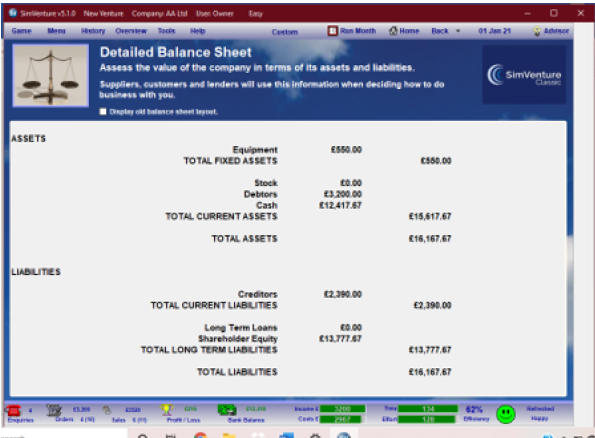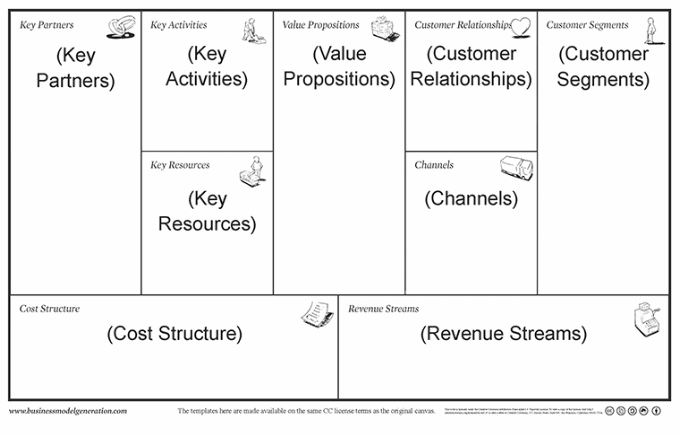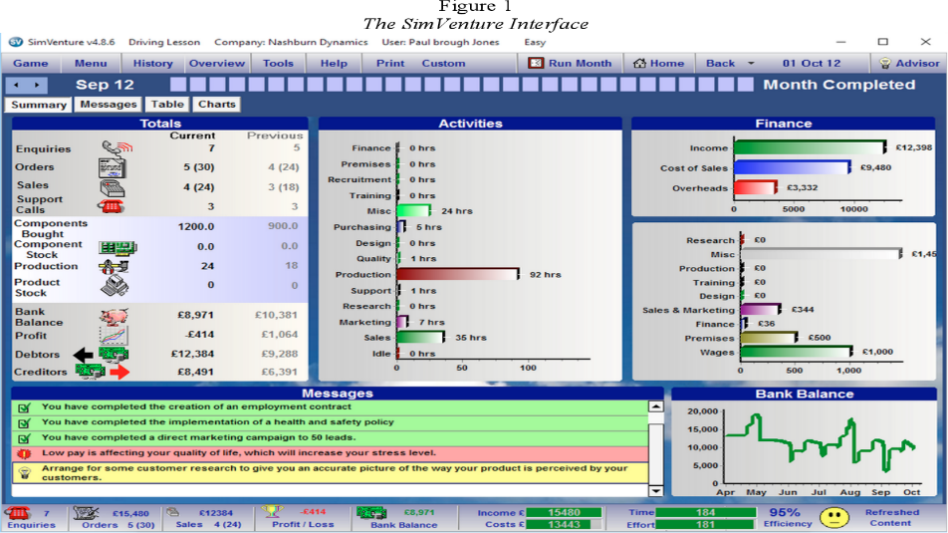Introduction
This report presents a twelve-month business simulation program using SimVenture. The company was named XYZ, and running it on SimVenture provided insights and awareness on how to manage a firm and boost its growth. It took a flat organizational setting, where it eliminated mid-level managerial functions. Moreover, the process employed technical principles, problem solving, self-management and customer awareness to ensure a smooth running (Yasin and Hafeez, 2018, p. 54). I mostly applied customer awareness and creativity in the game. These principles were my entrepreneurial skills and they are instrumental in helping me to understand key business drivers, and analyze facts when creating business solutions. Unlike the old learning methods, SimVenture enabled me to view the potential effects of one’s strategies and decisions (Aguilera-Castillo et al., 2020, p. 129). Overall, the framework enabled me to try, fail, but still try again until the learning objectives have been actualized.
The game helped to bridge the gap between classwork theory and the real-time applications. The customer segment comprised technological companies whose customers were also divided into various groups based on demographic factors such as age, gender, purchasing behavior, priority needs, and interest. From the program, it has been easy to address customer feedbacks when conducting market research, promote the business through various advertising techniques, and earn profit. During the first few months, the business experienced losses, but it regained productivity by the sixth month and earned a profit of 1890 pounds. Running and managing the business requires creativity, technical capabilities, business knowledge, communication skills, and problem-solving abilities.
Marketing
Various theories and approaches were used to promote the business and win customer loyalty. I applied the four Ps (price, product, promotion, and place) as the primary marketing theory. According to the course content, “Marketing management is the art and science of choosing target markets and getting, keeping, and growing customers through creating, delivering, and communicating superior customer value” (Module Notes, no date). Value proposition was also necessary during market research to gather information on consumer behavior (Eger and Micik, 2017, p. 142). The proposed values include high quality and customer-satisfying performance. In the game, I observed the customers’ behavior to address specific needs, and eventually attracted more them.
Further, I focused on building great customer relationships to win their loyalty. Using trade magazines and newspapers in the game, I established a wider customer base. I ran the promotion for two months and it enabled me to familiarize myself with the customers’ desires. In this course, some customers noted that company XYZ overprices their goods; hence, it was responded to by offsetting the price by $80 to increase sales and still maintain a substantial profit. As the company grows, the prices would still be reduced to ensure that products are affordable to all buyers.
Another theory I applied was segmentation, targeting and positioning (STP). Consumer segmentation enabled company XYZ to target large corporations that required large quantities of the product. Strategic planning throughout the game was necessary to set targets to achieve within certain periods. Prior to the activity, I projected a six-month plan, which subsequently guided decisions. The step was successful because I, first, identified the data to collect, gathered them from relevant resources, analyzed and established effective communication between customer service and marketing units in the virtual company. Strategic planning and appropriate financial analyses throughout the game ensured that I made the right decisions when running the virtual company.
Financial Highlights
I also used the software to analyze financial matters of the virtual company XYZ. From the course content, I applied profit and loss analysis as the primary theory when presenting overall expenditures. Profit and loss accounts are useful in assessing a business’s net income to facilitate decision-making processes (Module Notes, no date). They are used to calculate corporation and income tax, and failure to record them correctly can lead to the payment of additional penalties and interest. Company XYZ chose to approach an overdraft bank of $20, 000 for the business startup. Loaning was risky because I was uncertain about the profits the business would accrue.
However, “everyone can establish a financial ark to survive and succeed in the future” (Module Notes, no date). The initial capital was $30, 000, including the money that it spent on market research before borrowing from the bank. In the second month, the company intensified promotion through the aforementioned trade magazines and newspapers, amounting to $3200. This step increased sales, earning more profits to the organization.
In the third month, company XYZ changed its product supplier, after noting that the initial one charged higher fees. The second supplier sold its computers at significantly lower prices, enabling the company to offset its costs per unit. Prior to this realization, the company had lost a few customers who thought the products were extremely expensive. Therefore, it incurred $1050 more to conduct further market research to improve sales performance. The study showed that XYZ did not perform well due to high prices. It, therefore, utilized the advantage of the cheaper supplies to reduce prices by $150. In response, the company’s sales rose drastically and many customers became loyal and referred their peers to the company.
As the first year nearly ended, company XYZ had succeeded in large sales volumes and it ended the year with cumulative income of more than $500, amounting to over $3500. The financial analysis was necessary to evaluate the company’s sustainability. The assessment showed that after incurring drastic losses in event of initially losing customers, company XYZ started again by making a profit of close to $30.
Figure 1: The Company’s Financial Report and Cumulative Profits.
The analysis shows that company XYZ faced tremendous challenges but it struggled to maintain its production levels and sales in the first half of the year. The company also saw negative cash flows because it employed one person to manage financial reports, leading to poor performance and workloads. Therefore, it had to incur additional recruitment costs to resolve the issue. As the initial period ended, the company calculated its financial ratios and analyzed them as follows (My Accounting Course, no date):
Return on Capital Employed (ROCE) = IncomeBeforeInterest *Tax/ CapitalEmployed = 3500/3000 = 1.7 per cent
Since the company initially had $ 12000 before borrowing from the bank, the ROCE reveals that it generated substantial amounts of profit despite experiencing challenges with pricing in the first ha half the year. In the long run, the company would not require external funding, as the profits were significant enough to cater for expansion. Company XYZ’s financial forecasts revel that it can make close to double the amount of monthly sales made in the first year. This is possible because the company could make up to 30 sales per month due to the strong promotional strategy it initially implemented.

Human Resources
SimVenture enabled me to exercise ethical management skills that ensured fair treatment of all employees. The main theory involved was people management and operative functions such as procurement, recruitment, and ensuring employee welfare. In the game, Company XYZ advocated this role by engaging in activities that enhanced value and credibility. It upheld intent through good quality products and served customers with respect to increase organizational credibility (Lisi and Malo, 2018, p. 92). The course material on human resources emphasizes “the ability to collect information, develop alternatives and foresee potential risks and consequences” (Module Notes, no date). By applying the new knowledge, I noticed that one employee was facing burnout issues and was less productive. A new accountant was recruited to assist in monitoring the company’s financial records.
Through the game, I applied recruitment knowledge to develop and retain high performance employees. The process had to be sequential to ensure that employees were selected and assigned tasks then trained and paid. This framework adhered to the conventional human resource planning and job analysis design (BC Campus, no date). In the long run, it fostered the development of knowledge and skills, loyalty winning among employees and customers, as well as performance improvement. The step that company XYZ employed was career fair, which enabled them to provide information for potential employees and sold its good impression to them. Candidates interacted with the company’s executives and asked questions to receive appealing responses on the needed job. Company XYZ planned that, in the future, it would utilize job fairs, where potential employees would contact the company online.
Throughout the first year, the human resource department ensured effective recruitment and selection, as well as team working. The company used evolution to assess commercial and business acumen before hiring workers. This approach enabled them to analyze data, make decisions, and evaluate consequences. Working remotely, they used team assignments to test interpersonal and business skills among job seekers. For its current and future plans, the company decided that it promotes an active learning environment and outsources specialized trainers to monitor progress remotely. It also enabled the company to change settings, such as location to cope with challenges and assess regular performance. The technology could support large-scale events where employees competed for award winning, or collaborated for unified success.
Operations
SimVenture was used to simulate several operations in company XYZ. Simulation was done to operate stock control and to order products. Quality assurance and improvement were also performed in the game. In the game, I modeled, analyzed, visualized, and optimized the complexity of company XYZ’s logistics. Through product planning and control, which was the primary theory in operations, I was able bridge the gap between demand and supply to ensure that processes are efficient and effective in satisfying customers. This management facet required timely changes, such as addition of staff and price changes, to meet organizational goals. As stated earlier, the organization had employed one primary operator and it had to add more workers to reduce workload and improve productivity. Thus, operations focused on the “people element, not tech for tech’s sake,” as stated in the Module Notes (no date). In the future, the company will raise its prices following the increased demand for electronics in the region within which it operates. It also planned to utilize employment contracts when recruiting future employees.
Moreover, the company changed its operational location in the game after identifying regular and increasing customers. As schools resumed studies, company XYZ earned additional sales of more than 30 products. Customers appreciated and became loyal to the company because it reduced travel distance, helping them to save on cost. It was able to establish and maintain stronger relationships with buyers, apart from upholding product quality for them.

Technology
SimVenture was a business simulation technology that facilitated virtual development of company XYZ, and engaged the operator’s mind in ensuring a meaningful learning process. The main theory used was customization to suit consumers and “bring work to men” Module Notes (no date). In the course of this project, the software provided a clear business context for students and tutors, demonstrating how various business disciplines, including human resource management, marketing, as well product planning and logistics fit together.
It enabled the operators to multitask by managing money, observing time, developing skills, and watching their stress levels to identify any potential downfall in running operations. The software inspired the user’s development of critical thinking as it offered the opportunity to practice and fail before realizing the best strategy to run a business. Employing this technology promoted teamwork and appropriate decision-making when handling operations in a coherent and easy to understand manner. The figure below shows a screenshot of how the interface appeared.

The richness of information contained in the program facilitate handling a breadth of issues, as well as monitoring and evaluating business progress. For instance, it was possible to note the losses the company made while prices were high, and it was also easy to adjust by reducing prices and changing the supplier to the one who offered products at lower prices. The save and load function in the software allowed the operator to test different decision-making options. Its primary features include authenticity and engagement, which ensured sustainable learning, flexibility and varied technical and contextualized support. Data used to communicate with the board included demographic characteristics, profit, loss, total income and sales. Other data was not used in decision-making. The information applied was exported to Excel software for analysis.
Related technologies include Zoom Simulations, Capsim Cesim Global Simulation (CGS), which can facilitate appropriate business data analysis. Like SimVenture, it is an instructor resource in corporate settings and school programs. Millera et al. (2018, p.188) studied CGS and found that more collaborative groups spent much time in the simulation, achieving higher game positions, which are connected to market positions in business. The software established co-occurrence networks with phrases organized by variable headings as displayed earlier in the screenshots. They also have a special differentiation structure, where the teams exhibiting it scored higher in the simulations.
Conclusion
The project focused on engineering segments, where company XYZ manufactured and sold personal computers. It utilized consumer segments based on needs, interests, age, gender, and spending habits. The first four months faced significant losses but its downfall was used to conduct a market research that facilitated strategic planning. Afterward, the company noted consumer needs and change its location. It changed its pricing strategy to meet their desires and increase sales volumes. The game enabled me to run a six-month simulation for company XYZ. Through it, I learned how to operate and maintain a business, while boosting its growth. The experience enabled me to learn that several issues are factored in when running an organization. Moreover, the game enabled me to gain insights on how to run a business successfully. It also emphasized why and how to focus on customer satisfaction, which might need operational restructuring. Overall, I was satisfied through the project and I advocate for its implementation in basic and advanced learning stages.
During Company XYZ’s operations, it was noted that many decisions were needed to attract and maintain customers, as well as to earn sustainable income. Each step taken affects organizational performance, for example, lowering prices, employing more workers, and changing its location, while maintaining customer satisfaction. Moreover, responding to consumers’ feedback is necessary to maintain the current customers and receive referrals from them. I would conduct intensive market research to ensure that I familiarize with the ruling market prices to avoid making losses, which company XYY made before realizing cheaper products and setting affordable prices. The framework can be used in the future product design at company XYZ.
Reference List
Aguilera-Castillo, A. et al. (2020). ‘Simulations in business education: a case study of Cesim™ global challenge’, In Teaching, Learning, and Leading with Computer Simulations. IGI Global.
BC Campus. (no date). Achieving high performance through human resource management. Web.
Eger, L. and Mičík, M. (2017). ‘Customer-oriented communication in retail and net promoter score’. Journal of Retailing and Consumer Services, 35. Web.
Lisi, D. and Malo, M.A. (2017). ‘The impact of temporary employment on productivity’. Journal for Labour Market Research, 50(1). Web.
Millera, A. H. et al. (2018). ‘Analysing the use of business simulation to build entrepreneurial leaders: the case of UAE learners’. International Journal of Creativity and Learning, 9(9). Web.
Module Notes. (no date). Marketing, operations and IT, finance, human resources.
My Accounting Course. (no date). Return on Capital Employed. Web.
Yasin, N., and Hafeez, K. (2018) ‘Enterprise simulation gaming: effective practices for assessing student learning with SimVenture Classic and VentureBlocks’, in Denis, H. and Elizabeth F.C. (eds.) Experiential Learning for Entrepreneurship. Cham: Palgrave Macmillan, pp. 51-69.
